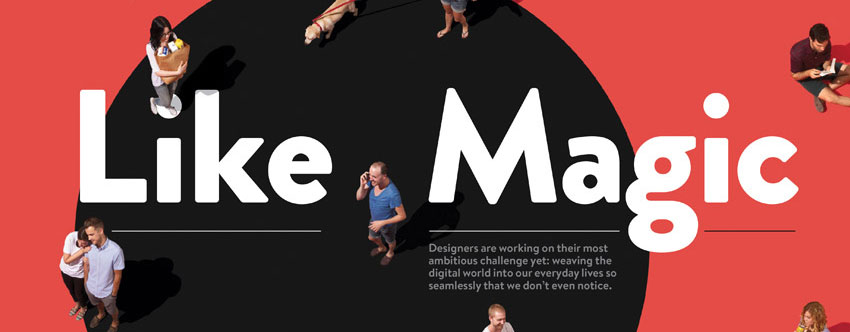Why a New Golden Age for UI Design Is Around the Corner
Over the past four years, the Walt Disney Company has been engaged in a secretive effort to redesign the Disney World experience. It’ll go like this: You buy your ticket online and plan all the details of your visit. Then you’ll get a wristband in the mail, which will be a passport to the experience that you’ve curated. Snug around your wrist, the so-called MagicBand will use radio frequency to communicate with sensors around the park, all orchestrated by software that effectively turns Disney World into a computer interface. You can enter the park by holding your hand up to a kiosk; you can arrive at shows with 30 seconds to spare, having already reserved your seats; you can jump onto rides you’ve selected at preselected times without waiting in long lines; you can buy anything you want with a wave. An It’s a Small Worldcharacter could call you by name and wish you happy birthday. So could Mickey, who can also greet you at a preselected meeting time. This is all in the service of fun, of course, but it is also a glimpse of the future: an integrated experience, a smooth hybrid of real-world and digital interactions.
This represents a new frontier for design. Over the past 30 years, as every facet of our lives, from our shopping to our schooling, has migrated onto computer screens, designers have focused on perfecting user interfaces—placing a button in just the right place for a camera trigger or collapsing the entire payment process into a series of swipes and taps. But in the coming era of ubiquitous sensors and miniaturized mobile computing, our digital interactions won’t take place simply on screens. As the new Disney World suggests, they will happen all around us, constantly, as we go about our day. Designers will be creating not products or interfaces but experiences, a million invisible transactions.
Already we’re seeing a groundswell of new products that insinuate themselves seamlessly into users’ lives. These include personal sensors like Jawbone’s Up, the voice- and gesture-controlled Xbox One, hyper-intelligent apps like Highlight that alert you to interesting people in your immediate vicinity, and Automatic, a gadget that communicates with your smartphone to tell you when you are driving inefficiently. But this is just the beginning. Within the next five years we will be surrounded by embedded devices and services. Just as the rise of the screen challenged designers to create software interfaces, the rise of screenless digital interactions will challenge them anew. After all, it’s one thing to invent a unique kind of digital experience in Disney World, a controlled space where people expect magic. It’s altogether trickier to do the same thing in people’s houses, offices, and bedrooms—the most intimate areas of their lives—in a way that feels both natural and inevitable.
Bill Buxton bears a striking resemblance to Doc Brown from Back to the Future—more strapping than you’d expect for a mad scientist, his bald head rimmed with a snowy hedge of hair. In conversation, he can be piercingly intense. And just like Doc Brown, in 1985 he unleashed a breakthrough. Buxton, a lifelong musician who has also worked for Xerox PARC and Silicon Graphics, created one of the world’s first multitouch interfaces when he turned an electronic drumhead into a tactile synthesizer control. That drum was a progenitor of every touchscreen in use today.
In the mid-aughts, Buxton wrote a journal article that helped define a new discipline called experience design—a focus not on products or devices themselves but on the impact they have on people’s lives.As an example, he wrote about two orange juice presses—an electric model and a manual lever press called the OrangeX. The electric juicer had flimsy plastic buttons, and the motor screeched to life with an annoying whir. The OrangeX required a bit more effort but also sported an inverted rocker crank that gradually transmitted more force as you pressed down. Buxton’s point was that the OrangeX created a feeling of tangible mastery that helped him enjoy the juice more. Designers didn’t shape just gadgets but behaviors and visceral responses around those gadgets.
Today, Buxton, who is principal researcher at Microsoft Research, says that the next challenge for experience design is to create a constellation of devices, including wearable gadgets, tablets, phones, and smart appliances, that can coordinate with one another and adapt to users’ changing needs. This focus on the totality of our devices stands in contrast to where we find ourselves today: constantly adding new gadgets and functions without much thought as to how they fit together. (For instance, anyone lugging around a laptop, iPad, and iPhone is also carrying the equivalent of three video cameras, three email devices, three media players, and probably three different photo albums.) Even as our devices have individually gotten simpler, the cumulative complexity of all of them is increasing. Buxton has said that the solution is to “stop focusing on the individual objects as islands.” He has come up with a simple standard for whether a gadget should even exist: Each new device should reduce the complexity of the system and increase the value of everything else in the ecosystem.
To see what he means by increasing the value of the ecosystem, consider the phone syncing built into many cars. After you link your phone, the vehicle boots up its own voice-recognition technology so you can make hands-free calls. When you leave the car, you simply grab your phone and it blinks to life again. The car and the phone engage in a quiet dialog geared toward providing only the capabilities you actually need at any moment.
Read More: Why a New Golden Age for UI Design Is Around the Corner


Comments (0)